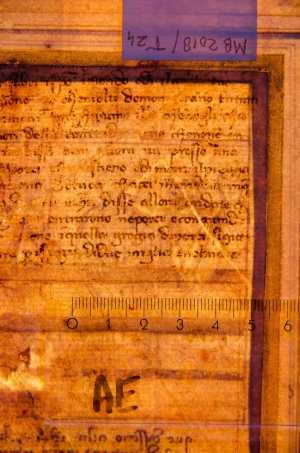Specifications
| Title | Jesus Casts out the Demons |
|---|---|
| Material and technique | Pen and brown ink |
| Object type |
Drawing (recto)
> Drawing
> Two-dimensional object
> Art object
|
| Location | This object is in storage |
| Dimensions |
Height 163 mm Width 90 mm |
|---|---|
| Artists |
Artist:
Anoniem
|
| Accession number | MB 2018/T 24 recto (PK) |
| Credits | Purchased with the support of VriendenLoterij, 2018 |
| Department | Drawings & Prints |
| Acquisition date | 2018 |
| Creation date | in circa 1390 |
| Watermark | Posthorn (fragment, 42 x 36 mm, on P2 van 2P, vH), as in the manuscript in Florence), tracing illustrated in Degenhart/Schmitt 1968, vol. 1.2, pp. 653, 658, WZ 78, similar to Briquet 7645: Florence (1364, 1370), Siena (1365) and Pisa (1366). [see image] |
| Inscriptions | handwritten text in Italian (both sides, pen and brown ink) |
| Mark | J. Richardson Sr. (L.2183), J. Barnard (L.1420), B. West (L.419), J.D. Böhm (L.272), A. Grahl (L.1199) |
| Provenance | (?) Biblioteca Riccardiana, Florence; Jonathan Richardson Sr. (1665-1745, L.2183)*, London; John Barnard (1685-1764, L.1420)*, London; - ; Benjamin West (1783-1820, L.419)*, London; (?) Joseph D. Böhm (1794-1865, L.272, L.1442 desunt)**, Vienna; August Grahl (1791-1868, L.1199), Dresden; his sale, London (Sotheby's) 27-28.04.1885, lot 167 (BP 1/10/0); Anon. (indistinct triangle mark, not in Lugt); Dr Modern, Vienna; Benno Geiger, Vienna/Venice; his sale, London (Sotheby) 07.12.1920, lot 158; Licht (?); Edwin Czeczowiczka (1877-1971), Vienna; his sale, Berlin (Ball, Graupe) 12.05.1930, lot 18, pl. 8 ((?) DM 1200 to Colnaghi); - ; sale, Bern (Gutekunst & Klipstein) 05-06.10.1950, no. 79, pl. 4 (Italian, 14th century); - ; sale, Munich (Karl & Faber) 04.05.2018, lot 123 (to Johan Bosch van Rosenthal, ArtConsult, Amsterdam, for the museum); Purchased with the support of FriendsLottery, 2018 |
| Research |
Show research Italian Drawings 1400-1600 |
| Literature | Grahl 1885, no. 167, ill.; Planiscig/Voss 1923, no. 1, pl. 1 (Central Italian, Bolognese?, second half 14th c.); Degenhart/Schmitt 1968, vol. 1.1, no. 99, vol. 1.3, pl. 153a-b (Florentine, c. 1390) |
| Material | |
| Object | |
| Geographical origin | Italy > Southern Europe > Europe |
Do you have corrections or additional information about this work? Please, send us a message
























